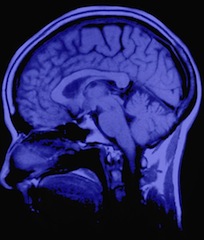A number of years ago, when I was at Scotland Yard in London researching Jack the Ripper, I was offered a rare tour of the famed but steeped in mystique “Black Museum,” personally conducted by its noted curator, former homicide detective John Ross. In the first room, on a high shelf along one wall, is a collection of plaster molds of heads of convicts executed during the 19th century.
The reason these molds were made was to apply the new “science” of phrenology to the understanding of criminal behavior. It was believed that by examining the size, shape and surface characteristics of the skull, one could derive insight into the working of the brain and what made these individuals go bad.
We no longer hold much faith in examining head bumps to figure out why some people turn to crime, but I’m not sure our subsequent attempts have yielded much more insight.
Since long before the time of Freud, there has been a quest among psychologists and neuroscientists to look for physical indicators to explain aberrant behavior, and every time we come upon something new, we seem to believe we are just on the verge.
In 1966, an architectural engineering student and former Marine named Charles Joseph Whitman rode to the top of the 307-foot clock tower at the University of Texas at Austin, well supplied with a shotgun, two rifles, an M-1 carbine, two handguns and seven hundred rounds of ammunition. Prior to this he had stabbed to death both his wife and mother. In the hour and a half before he was killed by two intrepid Austin police officers, he had murdered 13 strangers and had instantly become known worldwide as “the sniper in the tower.”
I bring up this notorious, seemingly motiveless mass murderer because when a full autopsy was performed, it was noted that Whitman had a small tumor, “in the middle of the brain, above the red nucleus, in the white matter below the gray center thalamus.” So that explained Whitman’s murderous behavior. But for this definable, physical factor, this tragedy would not have occurred.
But wait a minute. How does a tumor explain both the murderous impulse and the meticulously careful planning that went into Whitman’s action? I consulted the distinguished forensic neurologist and psychiatrist Richard Restak, M.D., who has written many books on the mind-brain connection and edited the special issue of the journal Seminars in Clinical Neuropsychiatry devoted to “Brain Damage and Legal Responsibility.”
After examining the Whitman medical examiner’s report he commented, “Lesions in the frontal lobe have been associated with psychopathological responses. But this tumor near the midbrain could not be considered a frontally mediated psycopathy. Nor is it the kind that would affect control of impulses or planning. In this case, there would be more than a couple of synapses between the stimulus and response, and the more of these we have, the more possibility we have of self-reflection before considering any action.”
In other words, so far as we can tell, the tumor was just an incidental finding.
Now we are into the brave new world of neural imagining and its promise of complete brain-mapping that will allow us to know from whence every thought and human motivation arises. But not so fast. Even the great Dr. Wilder Penfield, who more than a generation ago conducted neurosurgery on awake epilepsy patients and evoked specific vivid emotional experiences by electrically stimulating parts of the brain, declared there was a definite distinction between the brain and the mind and that the mind was a mysteriously distinct entity.
Despite our attempts at total reductionism that would make all behavior simply the result of definable electrochemical stimuli, no such insights are coming our way. While we can explain some mental and emotional deficits in terms of physical insults to the brain – stroke and Alzheimer’s disease come immediately to mind – there remains no mechanism that explains either why we do the good or bad things we do, or how the balance of nature versus nurture affects our individual outcomes.
For the foreseeable future at very least, human behavior remains its own realm, and we may still speak of character, conscience, and criminal personality rather than biochemistry.
Many of us in the criminal justice community believe in evil as more than just a metaphysical concept. And thus far, science has no adequate response.




























Firstly, thanks for an informative, interesting site.
I recently finished reading a book by a forensic psychiatrist (Helen Morrison). An extremely interesting book in its own right. In essence, she is of the view that something goes awry in the circuit of the brain of serial killers. In other words, they are a product of faulty design.
Although I am open to this possibility, I don’t know enough to entirely subscribe to this view, but I have yet to understand the dynamics whereupon only one child in a dysfunctional family becomes a serial killer. Or indeed, with so many dysfunctional families, why serial killers are so rare. I wonder if one day science will provide the definitive answer.
I’ve grown weary over the years, when speaking about either death penalty or rehabilitation (and how if doesn’t work on psychopaths), with the belief that many people have that all these serial violent offenders have brain tumors. Somewhere they have read one thing that said one guy had a brain tumor, and now they believe everyone has them. Even if it were true, I just don’t see how this changes anything. We don’t know how to fix it or prevent it, so we have to contain it. Belief someone is born that way is often used as a reason why we should have mercy on criminals since they can’t help themselves. If a person is going to continue to kill, regardless the reason, shouldn’t the lion’s share of mercy be shown for past and future victims? I don’t understand why so many people are willing to expend all their mercy on the killer and none on the victims. How can this be logical to them? What in them makes them want to justify this destructiveness? That idea that someone can’t help it; therefore, we should not punish them is more pervasive in society than I would have imagined possible, and I meet it even among my well-educated fairly well balanced friends. They will apply that logic to anything from cheating husbands to serial killers. I say, We have to stop the cycle. And they say, But if they were born with it, there isn’t a cycle. I say, If a kid grows up with a father who is a monster and that is his model, it doesn’t matter if the kid inherited a tumor or not; it’s going to affect him, and mostly likely not in a good way. If that blameless killer kills his kids’ mother and we don’t punish him, that sends the message that this is acceptable. Sometimes their final argument is, That’s not for us to judge in this life; they will be judged in the hereafter. I say we have brains, no matter how we got there, and we’re supposed to use them and no one with a brain can justify tolerating serial killers running free at the expense of innocents.
Well said. It seems as if we run from responsibility in this society.
Dear Mr. Olshaker,
I don’t think we are all trying to run from responsibility, so much as we do not understand what one another are saying particularly in the realm of philosophy and religion. Believe me SSA, it has everything to do with faith and upbringing. For example Robert Ressler was in the boy-scouts with John Wayne Gacy, he was born into Vietnam War, and he and others like Dr. Robert Keppel, John E. Douglas, David Reichert all prevailed. They stand for what is right and good, they have faith and love for the knowledge of persons. The adversaries your generation has fostered did not. Instead they rebelled, they said it was a pointless war and it was not. Communism is very oppressive and those men who like my uncles fought for us then do not realize they were merely fighting for our future. Communism like Fascism and like cancer all spread.
As far as the pseudoscience of Phrenology, I know we can do a lot better in understanding the why. For example we can give a MRI which is a measure of the brains activity to a given stimulus and measure the activity. If one of us who love and protect the innocent were to take an MRI and compare it to any serial killer or psychopathic individual we would see very different results. You and I process words and Ideas differently, namely with emotion. This can all be recorded and they do not. For example if I sit down and am given a radioactive dye that will allow Magnetic Resonance to record it will show the physician what areas of my brain are used when I process certain words that are scrambled. And the words are such that I must assemble them then when I have I click a button. The psychopath given the same task does just that and no more! In other words it is a very conclusive way to study psychopathy, we can see that in general the normal individual assembles the words and when the are akec,askt,apre,mredur…etc. We see that normal brains non-psychopathic individuals, all use a vast regions of their brain which the psychopathic individual does or maybe cannot. In conclusion there is very distinct electrochemical differences between the normal individual and the psychopathic individual, to summarize that the shape of the skull is responsible or indicative of a criminal mind is just fascist.